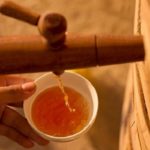What is the Nitrogen Level in Fish Sauce?
The nitrogen level in fish sauce refers to the total nitrogen content in one liter of the sauce.
The nitrogen content in fish sauce includes:
– Total Nitrogen: This is the total amount of nitrogen in the fish sauce (g/l) and determines its grade.
– Amino Nitrogen: This is the total amount of nitrogen in the form of amino acids (g/l) and determines the nutritional value of the fish sauce.
– Ammonia Nitrogen: Also known as putrefactive nitrogen, higher levels indicate lower-quality fish sauce.
The nitrogen level on the fish sauce label usually refers to total nitrogen.

While the nitrogen level is an indicator of the quality of fish sauce, it does not necessarily mean that a higher nitrogen content will result in better-tasting sauce. This is only true for traditional fish sauce, where the nitrogen content is natural (real nitrogen) and not adulterated.
For reference: Simple homemade chili garlic sauce
Differentiating Fish Sauce Based on Nitrogen Levels
Traditional Fish Sauce
– Traditional fish sauce is produced by hydrolyzing fish, exposing it to sunlight, allowing air to come in contact, and using digestive enzymes present in the fish’s intestines to inhibit bacteria and convert protein into absorbable nitrogen.
– The natural nitrogen level of pure fish sauce produced using traditional methods ranges from 30 – 40 degrees, and occasionally can reach 43 – 45 degrees, but this is rare.
– High-nitrogen traditional fish sauce usually has a reddish-brown color, a thick consistency, and a strong flavor.
– According to Vietnamese standards for fish sauce (TCVN 5107:2003), there are four types: Special (nitrogen level > 30 No), Superior (nitrogen level > 25 No), Grade 1 (nitrogen level > 15 No), and Grade 2 (nitrogen level > 10 No).

[captionnews]Chemical criteria for fish sauce[/captionnews]
Thus, traditional fish sauce with higher nitrogen levels is generally more valuable and commands a higher price.
Industrial Fish Sauce
Fish sauces with nitrogen levels from 50 – 60 degrees are typically produced with the help of technology, such as salt extraction or industrial methods.

[captionnews]Traditional fish sauce cannot reach nitrogen levels above 45 No[/captionnews]
These products are made by mixing one part pure fish sauce with hydrolyzed plant-based nitrogen, using various methods, and then adding flavorings and mixing with artificial nitrogen solutions.
Note
– Some fish sauce products on the market do not display the nitrogen level on the label but instead show the “protein content” (grams of protein per 100 ml of fish sauce). To convert this to a nitrogen level, divide the protein content in 1000 ml by 6.25.
– Some manufacturers may try to mislead consumers by replacing the total nitrogen content with the amino nitrogen content (usually much higher) on the label.
Is Nitrogen Level the Sole Determining Factor for Choosing a Quality Fish Sauce?
While considering the nitrogen level when choosing a fish sauce is necessary, relying solely on this factor may not guarantee that consumers will select a delicious and authentic sauce. The “nitrogen level” of fish sauce can be manipulated using various methods and may not always represent natural nitrogen derived from fish hydrolysis.

[captionnews]Nitrogen level is not the only criterion for choosing a tasty fish sauce[/captionnews]
A shared experience is as follows
– Traditional fish sauce has a slightly dark and clear color. In contrast, industrial fish sauce is very light in color. The color of traditional fish sauce tends to become darker over time after opening and using it.
– The aroma of traditional fish sauce is slightly strong, while industrial fish sauce has a faint and light fragrance. Traditional fish sauce leaves a strong smell on the hands that is difficult to wash off, whereas the smell of industrial fish sauce disappears immediately after washing.
– Traditional fish sauce usually has a longer shelf life of 2 – 3 years, which is longer than that of industrial fish sauce.
– Industrial fish sauce labels typically list ingredients such as flavor enhancers and preservatives.
With this basic information, we hope readers will have a more “accurate” understanding and make smarter choices when purchasing fish sauce.
The Ultimate Guide to Fish Sauce: A Flavorful Condiment
As a distinctive flavor enhancer in Vietnamese cuisine, fish sauce is a staple in every household’s kitchen. However, not everyone knows how to properly distinguish, select, and use this condiment in a way that is both delicious and safe for one’s health. Join us as we explore the intricacies of this beloved seasoning and discover the secrets to choosing and using the best fish sauce for your culinary creations.



































